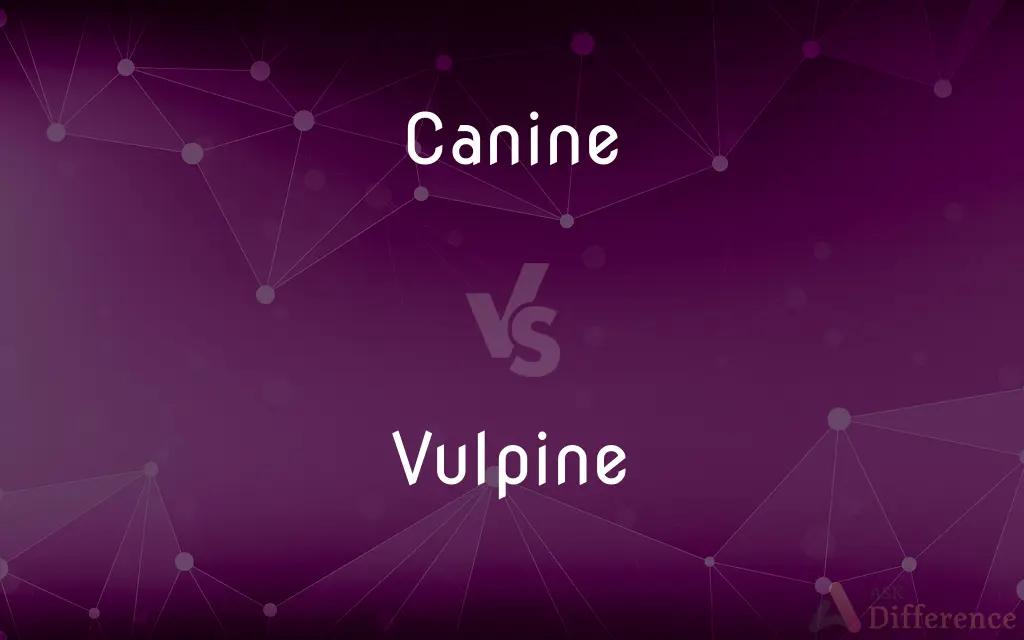Canine vs. Vulpine — What's the Difference?
By Maham Liaqat & Fiza Rafique — Updated on April 4, 2024
Canines are known for their loyalty and domestication, with a diverse range of breeds, while vulpines, related to foxes, are noted for their cunning and wild nature.

Difference Between Canine and Vulpine
Table of Contents
ADVERTISEMENT
Key Differences
Canines, encompassing domestic dogs and their relatives, are celebrated for their loyalty and versatility in roles from companionship to work. Vulpines, on the other hand, refer to characteristics or species related to foxes, embodying cunning and adaptability in the wild. While canines often live in close association with humans, serving in various capacities from companionship to working roles, vulpines are primarily wild animals known for their shrewdness and elusiveness, often depicted in folklore and stories as clever tricksters.
Canines possess a wide range of sizes, shapes, and temperaments, bred for specific tasks like herding, hunting, and guarding. Vulpines, however, display more uniform traits characteristic of foxes, such as agility, pointed ears, and bushy tails, emphasizing their adaptation to various environments but without the extensive domestication seen in canines. This diversity in canines reflects their long history of domestication and selective breeding, whereas vulpines retain their natural traits optimized for survival in the wild.
The social structures of canines can vary significantly, with some breeds displaying strong pack instincts, demonstrating cooperation and hierarchies. In contrast, vulpines are generally more solitary, with foxes often hunting and living alone or in small family groups, highlighting a difference in social behavior rooted in their evolutionary backgrounds. This distinction illustrates the communal versus solitary strategies adapted by these animals in their natural or domesticated environments.
Regarding intelligence, both canines and vulpines exhibit high levels of problem-solving skills and adaptability. However, canines are particularly renowned for their ability to understand and follow human commands, a result of domestication and training. Vulpines, while intelligent, tend to use their cognitive abilities for survival in the wild, showing a natural cunningness rather than the trained obedience found in many canines. This difference underscores the roles humans have played in the development of canine intelligence compared to the independent survival strategies of vulpines.
Canines and vulpines both play significant roles in human culture and mythology, but often in contrasting ways. Canines are frequently seen as symbols of fidelity, guardianship, and friendship, celebrated in stories and films. Vulpines, however, are commonly portrayed as sly and mischievous characters, embodying cunning and trickery. These cultural representations reflect the general perceptions and values humans associate with these animals based on their interactions and observed behaviors.
ADVERTISEMENT
Comparison Chart
Domestication
Highly domesticated, diverse range of breeds
Primarily wild, with little variation in breeds
Behavior
Social, often pack-oriented
Solitary or small family groups
Physical Traits
Varies widely among breeds
Typically agile, with pointed ears and bushy tails
Intelligence
High, trainable for specific tasks and commands
High, uses cunning for survival
Cultural Symbolism
Loyalty, guardianship, friendship
Cunning, trickery, independence
Compare with Definitions
Canine
Wild Canines.
Wolves use complex communication through howling, body language, and scent marking.
Vulpine
Red Fox.
The red fox adapts well to urban environments, showcasing its versatility and intelligence.
Canine
Working Dogs.
German Shepherds are often used in police and military roles for their intelligence and obedience.
Vulpine
Fennec Fox.
Fennec foxes, with their large ears, are adapted to desert life, using their hearing to locate insects and rodents.
Canine
Domestic Dogs.
Golden Retrievers are known for their friendly and tolerant attitudes.
Vulpine
Cultural Depictions.
In folklore, foxes are often depicted as tricksters, utilizing their wits to outsmart others.
Canine
Hunting Dogs.
Beagles are utilized for their excellent sense of smell and tracking abilities in hunting settings.
Vulpine
Conservation Status.
Some fox species face threats from habitat loss and hunting, highlighting the need for conservation efforts.
Canine
Companion Dogs.
Pomeranians are popular as lapdogs and companions for their small size and lively personalities.
Vulpine
Arctic Fox.
The Arctic fox changes its fur color with the seasons for camouflage in snow or rocks.
Canine
Of, relating to, or characteristic of the canids.
Vulpine
Of, resembling, or characteristic of a fox.
Canine
Of, relating to, or being one of the pointed conical teeth located between the incisors and the first bicuspids.
Vulpine
Cunning; clever.
Canine
An animal of the family Canidae, especially a dog.
Vulpine
Pertaining to a fox.
Canine
One of the pointed, conical teeth located between the incisors and the first bicuspids. Also called cuspid.
Vulpine
Having the characteristics of a fox; foxlike; cunning.
Canine
Of, or pertaining to, a dog or dogs.
Vulpine
Any of certain canids called foxes (including the true foxes, the arctic fox and the grey fox); distinguished from the canines, which are regarded as similar to the dog and wolf.
Canine
Dog-like.
Vulpine
A person considered vulpine (cunning); a fox.
Canine
(anatomy) Of or pertaining to mammalian teeth which are cuspids or fangs.
Vulpine
Of or pertaining to the fox; resembling the fox; foxy; cunning; crafty; artful.
Canine
Of an appetite: depraved or inordinate; used to describe eating disorders.
Vulpine
Resembling or characteristic of a fox;
Vulpine cunning
Canine
Any member of Caninae, the only living subfamily of Canidae.
Canine
(formal) Any of certain extant canids regarded as similar to the dog or wolf (including coyotes, jackals, etc.) but distinguished from the vulpines, which are regarded as fox-like.
Canine
In heterodont mammals, the pointy tooth between the incisors and the premolars; a cuspid.
Canine
(poker slang) A king and a nine as a starting hand in Texas hold 'em due to phonetic similarity.
Canine
Of or pertaining to the family Canidæ, or dogs and wolves; having the nature or qualities of a dog; like that or those of a dog.
Canine
Of or pertaining to the pointed tooth on each side the incisors.
Canine
A canine tooth.
Canine
One of the four pointed conical teeth (two in each jaw) located between the incisors and the premolars
Canine
Any of various fissiped mammals with nonretractile claws and typically long muzzles
Canine
Of or relating to a pointed conical tooth
Canine
Of or relating to or characteristic of members of the family Canidae
Common Curiosities
What characteristics are typical of vulpines?
Vulpines, related to foxes, are known for their agility, cunningness, and adaptability to various environments.
Are all canines domesticated?
Not all canines are domesticated; the category includes both domestic dogs and wild species like wolves.
Can vulpines be domesticated like canines?
While some foxes can become accustomed to human presence, they are generally not domesticated to the extent of dogs.
How do canines and vulpines differ in social behavior?
Canines often exhibit pack-oriented social structures, while vulpines tend to be more solitary or live in small family groups.
How do canines and vulpines interact with humans?
Canines are closely associated with humans as pets, working animals, and companions, while vulpines are more commonly observed in the wild.
Which are smarter, canines or vulpines?
Both are highly intelligent but use their cognitive abilities in different ways; canines are notable for their trainability, whereas vulpines excel in survival strategies.
What defines a canine?
Canines include domestic dogs, wolves, and other related species, characterized by their diverse roles alongside humans and pack behavior.
How are vulpines viewed in folklore and culture?
Vulpines are often depicted as clever and cunning, embodying traits of trickery and adaptability.
Do canines or vulpines have a greater impact on ecosystems?
Both have significant roles in their ecosystems, but canines, especially domestic dogs, can have varied impacts due to their interactions with human environments.
Do canines or vulpines have a wider range of physical diversity?
Canines have a wider range of physical diversity due to extensive breeding for various traits and purposes.
What roles do canines play in human societies?
They serve as companions, working animals, and symbols in cultural narratives and myths.
What challenges do vulpines face in the wild?
They contend with habitat loss, hunting, and competition for resources.
How do the hunting strategies of canines and vulpines differ?
Canines often hunt in packs, using cooperation and strategy, whereas vulpines are more likely to hunt alone, relying on stealth and cunning.
Can canines live in the wild like vulpines?
Some canines, like wolves, are wild animals, but domestic dogs rely heavily on humans for survival.
Share Your Discovery

Previous Comparison
Actual vs. Real
Next Comparison
Sparkle vs. TwinkleAuthor Spotlight
Written by
Maham LiaqatCo-written by
Fiza RafiqueFiza Rafique is a skilled content writer at AskDifference.com, where she meticulously refines and enhances written pieces. Drawing from her vast editorial expertise, Fiza ensures clarity, accuracy, and precision in every article. Passionate about language, she continually seeks to elevate the quality of content for readers worldwide.














































